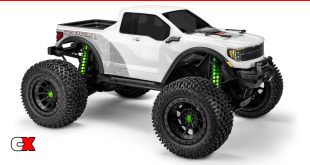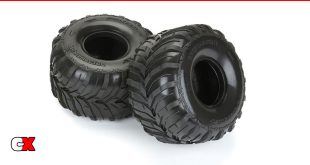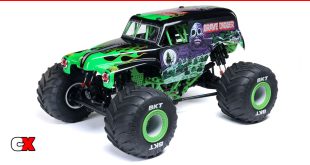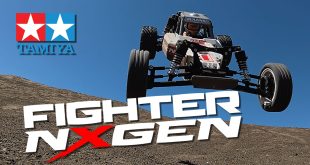Beginner’s Guide to RC – Explaining RC Brushless Terminology
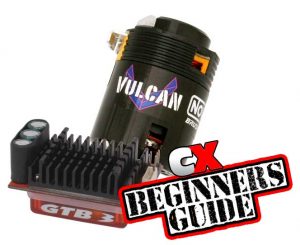
There are plenty of terms in the RC industry that can be confusing to a newcomer – most of those revolving around your brushless ESC and motor. While they may be a bit foreign, they are terms you’ll eventually need to know when looking to outfit your vehicle with the best RC brushless system.
CompetitionX has gathered up a list of the most commonly used terms and broken them down into two sections; RC brushless ESCs and RC brushless motors.
RC Brushless ESCs
 Voltage Input
Voltage Input
Voltage Input on any ESC refers to the number of cells the ESC can handle; each single cell has a specific number of volts. For NiCd and NiMh batteries, each cell registers 1.2v, while each LiPo cell registers 3.7v. So if an ESC says it can handle 2S-6S LiPo (like Castle Creations Mamba Monster X), it can handle up to 22.2v of power. The chart below can be used as a quick reference guide:
NiCd/NiMh cells – typically found in 4-cell, 6-cell and larger (in increments of 2 cells):
4 cells x 1.2 volts (4-Cell) = 4.8v
6 cells x 1.2 volts (6-Cell) = 7.2v
8 cells x 1.2 volts (8-Cell) = 9.6v
10 cells x 1.2 volts (10-Cell) = 12.0v
12 cells x 1.2 volts (12-Cell) = 13.2v
LiPo cells – typically found in 1S, 2S and larger (in increments of 1 cell):
1 cell x 3.7 volts (1S) = 3.7v
2 cells x 3.7 volts (2S) = 7.4v
3 cells x 3.7 volts (3S) = 11.1v
4 cells x 3.7 volts (4S) = 14.8v
5 cells x 3.7 volts (5S) = 18.5v
6 cells x 3.7 volts (6S) = 22.2v
8 cells x 3.7 volts (8S) = 29.6v
10 cells x 3.7 volts (10S) = 37.0v
12 cells x 3.7 volts (12S) = 44.4v
 BEC
BEC
BEC stands for Battery Eliminator Circuit and is an electronic circuit built into an ESC that supplies power to other components. Before the BEC, RC cars would need a separate battery pack to power other onboard items like the steering servo. This required the drivers to manage space on the chassis for an additional 4-6 cell mini pack, but thankfully that is no longer an issue now that the BEC has been introduced. Almost every current ESC contains a BEC.
 On Resistance (ohms)
On Resistance (ohms)
On Resistance is the restriction of current through an ESC to a motor at full speed. It’s measured in Ohms; the lower the On Resistance, the more efficient (and cooler running) the ESC is. Racing ESC’s, like Reedy’s Blackbox 410R, has high-quality MOSFETs resulting in an extremely low On Resistance … 0.00035 each.
 Continuous Current (amps)
Continuous Current (amps)
Continuous current is rated in amps and is the internal MOSFET’s ability to handle current over a continuous period of time.
 Peak Current (amps)
Peak Current (amps)
Peak Current is rated in amps and is the internal MOSFET’s ability to handle high current surges for a short period of time, usually 1-2 milliseconds.
 Motor Limit
Motor Limit
The motor limit tells you the specified range of motor turns that will work with the ESC. The motor limit depends on the input voltage that the ESC is being operated on.
 Brushed/Brushless Modes
Brushed/Brushless Modes
Some ESCs can be used with both brushed and brushless motors. A software setting inside the ESC will allow you to set it to work with either a brushed or brushless motor.
 Drag Brake
Drag Brake
Drag Brake is a setting that applies brakes to the Neutral trigger position. The brake power is adjustable for different RC applications.
 Neutral Width
Neutral Width
Also known as Dead Band, this is the space between the minimum drive and minimum brake; basically the position of the trigger when set to neutral. It can be adjusted to increase or reduce the initial action of either the drive or braking. A feature used mostly as a driver preference.
 Timing Profile
Timing Profile
Some ESC’s allow you to modify settings within the ESC software to manually increase or reduce the Timing to the motor. Advanced ESCs have multiple pre-set Timing Profiles; saved profiles with most common settings. This allows you to change to a different Timing Profile quickly and easily.
 Voltage Cutoff
Voltage Cutoff
Batteries should not be discharged past a certain point or you risk damaging them. If you run your car until the battery is dead, this could cause the pack to fail. To protect batteries like LiPos, they should not be run down past 3.5v per cell. The ESCs Voltage Cutoff senses when the pack is about to reach this limit and immediately reduces the power pulled from the pack, sometimes completely shutting off.
 “Blinky” Mode
“Blinky” Mode
ESCs have become very advanced and running in Spec classes where power is supposed to be equal became difficult to police. The “Blinky” Mode is a setting in almost all racing ESCs where the timing is set to zero. Typically, these ESCs also have a blinking LED to indicate they are in a Spec, non-boost mode.
 Boost
Boost
Boost refers to a timing feature within the ESC. Additional timing can be programmed to kick in at a certain RPM for an incredible boost in speed. The timing is typically set to ramp up with RPM; the faster you go, the more timing is introduced.
RC Brushless Motors
 Voltage Input
Voltage Input
The Voltage Input on a brushless motor is similar to that of an ESC; it basically describes the amount of volts that the motor can safely handle. You can use the chart above to calculate the Voltage Input with your battery setup.
 Rotor Shaft Size
Rotor Shaft Size
This is the diameter of the brushless motor’s rotor shaft. For 1:10 scale vehicles, the shaft is 3.17mm. For 1:8 scale vehicles, the shaft is 5mm. For 1:5 scale vehicles, the shaft is 8mm. These sizes are important when you are looking to buy pinions for your brushless motor.
 kV
kV
kV stands for KiliVolt. You can guesstimate the RPM of a brushless motor using the formula kV*volt. So, if you have a 5000kV motor running on a 7.4v pack, you could be generating 37000rpm at the motor. Use these guidelines when trying to determine the kV motor you want:
High kV:
• More speed, less torque
• Higher amp draw
• Can be geared down to regain some torque and reduce overheating
• Drains your battery fast – shorter run times
Low kV:
• Less speed, more torque
• Lower amp draw
• Can be geared up to increase speed without increasing temps
• Drains your battery slower – longer run times
 Rotor Size
Rotor Size
Brushless rotors come in different sizes. A smaller diameter rotor has higher RPMs but less torque; a larger diameter rotor has lower RPMs but more torque. You can install a different size rotor to tune the performance of the motor to the track size. Larger tracks = smaller rotor/more RPMs. Smaller tracks = larger rotor/more torque.
So there you go, useful information that should help guide you to your next purchase of a brushless system. Good luck!
Here are some other brushless motor articles you might be interested in:
Changing a Brushless Motor’s Rotor – Does It Really Make A Difference?
Brushless Motor Chart – Turns vs kV Rating
 CompetitionX CompetitionX is the most up-to-date source for RC Car News, Reviews and Videos for Radio Control. We also have the most comprehensive Manual Database on the web.
CompetitionX CompetitionX is the most up-to-date source for RC Car News, Reviews and Videos for Radio Control. We also have the most comprehensive Manual Database on the web.
